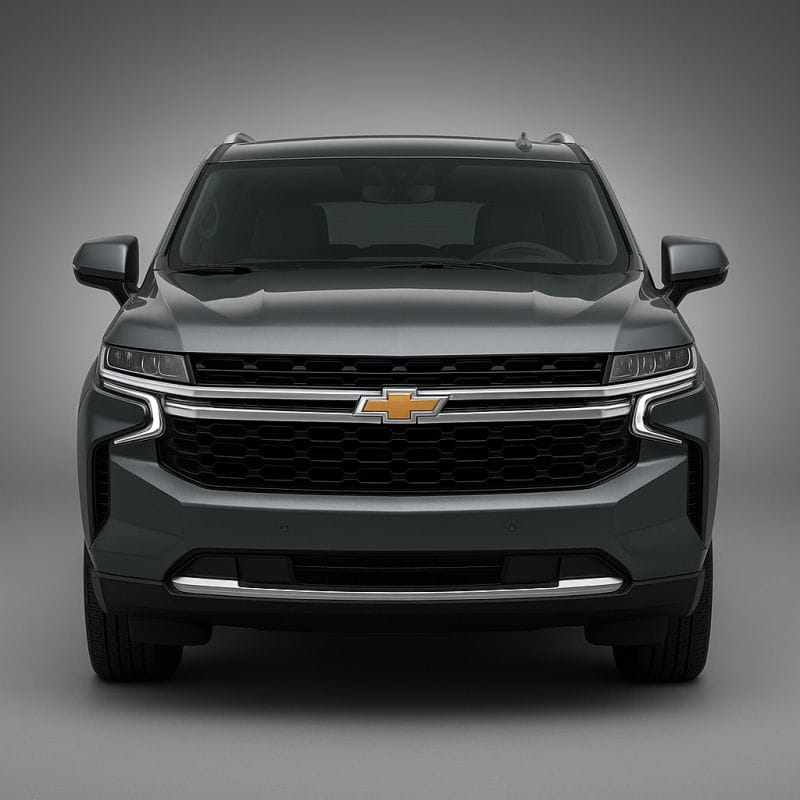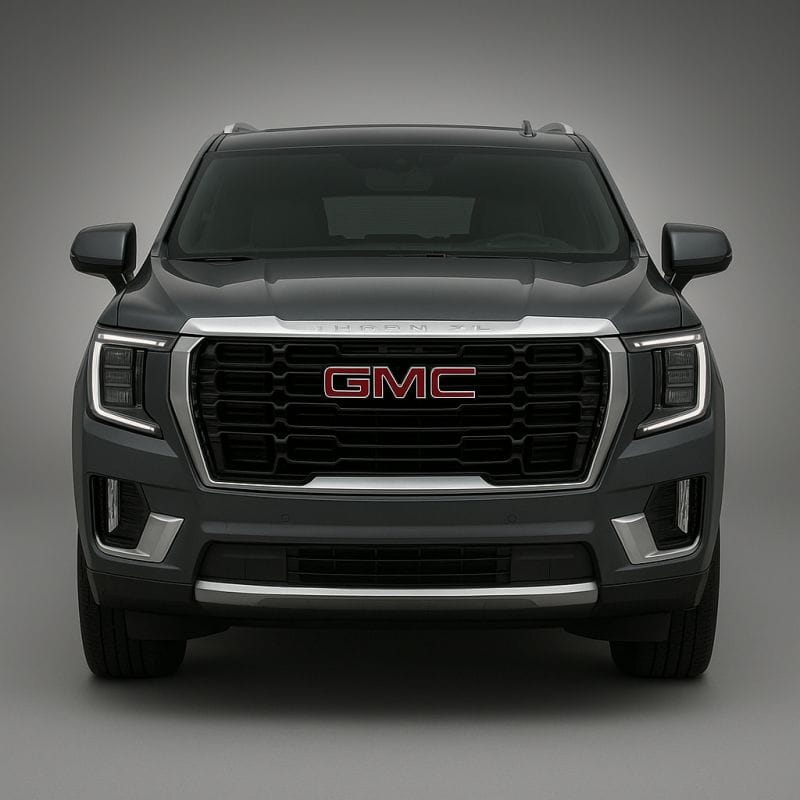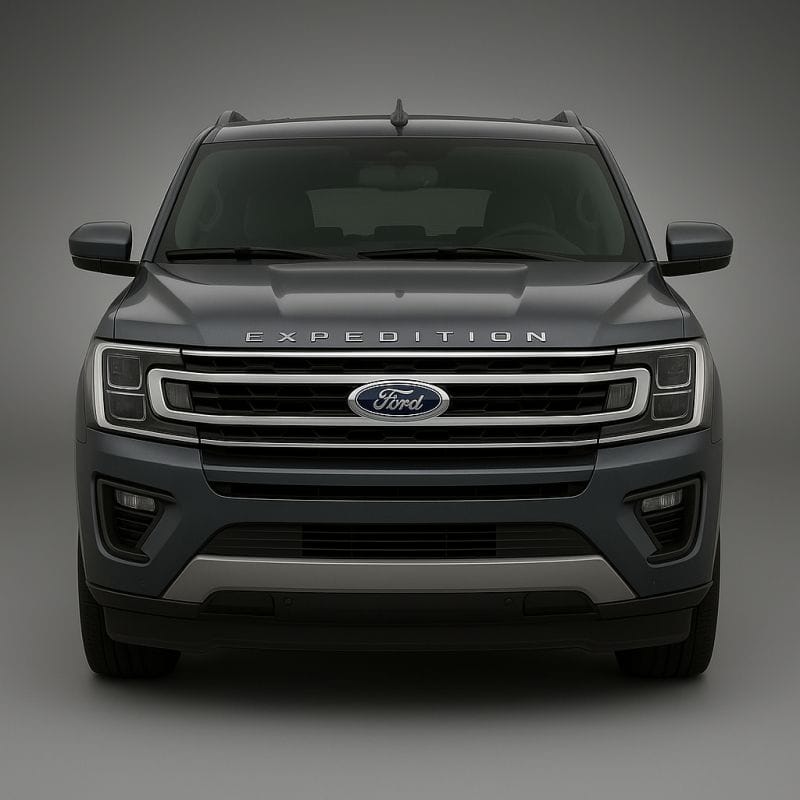Sixt’s GFAR class features full-size SUVs for travelers who want space, comfort and capability in one. With three row seating, generous cargo room and smooth highway performance these vehicles balance rugged utility with modern refinement and are ideal for family trips, group travel or long distance comfort.
Sixt GFAR
Find out which cars are included in the Sixt GFAR category
More About This Class
Chevrolet Suburban

For nearly nine decades the Chevrolet Suburban has been the go-to nameplate for anyone who needs a truly big American family SUV. In its latest generation GM has sharpened its flagship with larger screens, updated powertrains, and new driver assist technology, all in a bid to keep it competitive against rivals like the Ford Expedition and GMC Yukon XL. Still the Suburban comes with both strengths and compromises.
Chevy still offers three engine choices. The bread and butter option remains the familiar 5.3 liter V8 with 355 horsepower which is plenty for most buyers. Step up to the 6.2 liter V8 and you get 420 horsepower which hustles this nearly three ton SUV to 60 mph in just over six seconds in independent testing. For something this big that is impressive.
New to the lineup is the 3.0 liter Duramax inline six diesel. Output is 305 horsepower but the real story is its 495 pound feet of torque. That means the Suburban tows with authority with maximum ratings topping 8000 pounds depending on trim. Long distance drivers will also appreciate the mileage. While the V8s realistically return about 15 mpg in city driving the diesel can exceed 20 mpg making it the efficiency choice.
Every engine pairs with GM’s 10 speed automatic. It shifts smoothly most of the time although it can hesitate when asked for rapid gear changes. Buyers can stick with rear wheel drive or opt for four wheel drive.
| Specification | 5.3L V8 (EcoTec3) | 6.2L V8 (EcoTec3) | 3.0L Duramax Turbo-Diesel |
|---|---|---|---|
| Engine | 5.3-liter naturally aspirated V8 with Dynamic Fuel Management | 6.2-liter naturally aspirated V8 with Dynamic Fuel Management | 3.0-liter turbocharged inline-six diesel |
| Output | 355 hp | 420 hp | 305 hp |
| Torque | 383 lb-ft | 460 lb-ft | 495 lb-ft |
| 0–60 mph | about 7.5 seconds | about 6.1 seconds | about 8.4 seconds |
| Transmission | 10-speed automatic | 10-speed automatic | 10-speed automatic |
| Drivetrain | RWD standard, 4WD optional | RWD standard, 4WD optional | RWD standard, 4WD optional |
| Combined fuel economy | around 17 mpg (est.) | around 16 mpg (est.) | around 24 mpg (est.) |
| Towing capacity | up to ~8,300 lb (max trailering package) | up to ~8,200 lb | up to ~7,800 lb |
| Suspension | Steel springs, adaptive air suspension optional | Magnetic Ride Control standard on High Country, adaptive air suspension optional | Steel springs, adaptive air suspension optional |
| Starting availability | Standard on LS, LT, RST, Premier | Standard on High Country, optional on RST, Z71, Premier | Available on most trims including Z71 |
The Suburban’s chassis has not been radically changed but Chevy has added a key option. Adaptive air suspension combined with Magnetic Ride Control transforms the ride into something far more composed and comfortable on long highway stretches. Without it the Suburban can feel stiff and a little harsh over bumps.
Steering is light and easy in typical American fashion but it communicates little about what the front tires are doing. The Suburban leans early in corners and feels ponderous on twisty roads which is expected given its size. The Z71 trim looks trail ready with skid plates all terrain tires and a dedicated off road mode but in practice it is more of a style statement than a true off roader.
Inside the Suburban is vast. Up to nine passengers can fit and even the third row is adult friendly. Cargo space is enormous. With every seat in place it still offers more room than many entire mid size SUVs. Fold the rows flat and you get over 140 cubic feet of space.
The dashboard has been redesigned with a massive 17.7 inch touchscreen running Google Built In. It responds quickly and voice control works well. A new 11 inch digital cluster sits behind the wheel. Chevy has also dropped the button style shifter in favor of a traditional column mounted lever which is a welcome change.
Material quality ranges from functional in base models to upscale in the High Country trim. Real wood and fine leather create a premium feel at the top but some plastic surfaces remind you this is still a mass market SUV rather than a luxury model from Europe.
Standard equipment includes automatic emergency braking lane keeping assist blind spot monitoring and adaptive cruise control. New features include intersection automatic emergency braking and reverse automatic braking. Up to 13 available camera views make maneuvering easier which is important in a vehicle this size.
Optional is GM’s Super Cruise which allows hands free driving on mapped highways. It generally works reliably though it can change lanes more often than necessary which may annoy some drivers.
As cavernous as it is inside the Suburban is still a handful in daily use. At more than 225 inches long it makes tight parking garages a challenge. Fuel economy is another weak point. Even with cylinder deactivation the V8s consume heavily by today’s standards and while the diesel is better it remains thirsty compared with smaller SUVs.
Pricing is also significant. Base models start around 60000 dollars but a fully equipped High Country goes well past 90000. At that level some buyers will expect interior refinement that is closer to what European brands deliver.
GMC Yukon XL

The GMC Yukon XL is one of the cornerstones of the full-size SUV segment. It offers cavernous space and blends proven truck hardware with plenty of comfort. But in today’s market, sheer size isn’t enough. Buyers expect more than just acreage on the spec sheet. They want modern tech, long-haul comfort, and day-to-day usability. The Yukon XL aims to check all those boxes.
Under the hood you’ll find a choice of two gas V8s. The 5.3-liter makes 355 horsepower and 383 lb-ft of torque. It’s the sensible pick for families who mainly use the Yukon as a people hauler and don’t plan to tow heavy on a regular basis. Power delivery is adequate, and the 10-speed automatic does its best to keep things smooth while reining in consumption. Still, “efficient” isn’t a word you’ll ever use for this powertrain. Load it up with people and gear, and the thirst becomes obvious.
For more muscle, GMC offers the 6.2-liter V8 rated at 420 horsepower and 460 lb-ft. This is the engine that makes the Yukon XL feel genuinely relaxed, especially on the highway. Passing power is abundant, towing is easy, and the transmission pairs seamlessly with the bigger motor. The trade-off is predictable and fuel stops will be frequent no matter which V8 you choose.
| Specification | 5.3L V8 (EcoTec3) | 6.2L V8 (EcoTec3) |
|---|---|---|
| Torque | 383 lb-ft | 460 lb-ft |
| 0–60 mph | about 7.5 seconds | about 6.1 seconds |
| Transmission | 10-speed automatic | 10-speed automatic |
| Drivetrain | RWD standard, 4WD available | RWD standard, 4WD available |
| Estimated fuel economy | around 17 mpg | around 16 mpg |
| Max towing capacity | up to ~8,300 lbs (with Max Trailering Package) | up to ~8,200 lbs |
| Suspension | Coil springs standard, optional adaptive air suspension | Magnetic Ride Control standard on higher trims, optional adaptive air suspension |
| Trim availability | Standard on LS, LT, RST, Premier | Standard on High Country, available on RST, Z71, Premier |
On the road, the Yukon XL handles better than its sheer bulk suggests. The optional air suspension smooths out rough pavement and keeps the ride composed. Road and wind noise are impressively low, which helps make long drives a calm experience. At the same time you never forget you’re piloting more than 224 inches of SUV. Parking garages and tight downtown streets aren’t its natural habitat. Steering is light and easy at low speeds but doesn’t give much feedback. If you’re after sharp handling, look elsewhere.
Inside is where the Yukon XL really shines. Space is generous across all three rows, and even adults can ride comfortably in the way-back. Cargo room remains usable with every seat occupied, and when you fold them down the Yukon turns into one of the biggest haulers in the class. Fit and finish feel solid though not quite as polished as its Cadillac Escalade cousin. A large central touchscreen and a digital gauge cluster dominate the dash. The interface is intuitive, and Google-based navigation makes travel easier. Rear-seat entertainment screens are available for long family road trips. Higher trims pile on the luxury with features like front-seat massage and an upgraded premium audio system. While it doesn’t quite hit European luxury benchmarks, it comes surprisingly close.
Safety tech is generous too. Automatic emergency braking, cross-traffic alerts, and a surround-view camera system are included, making it less stressful to manage such a massive vehicle. The downside is that the warnings can feel overeager in everyday driving.
The Yukon XL’s biggest drawback remains fuel economy. Even driven gently, real-world numbers are stubbornly in the double digits. Buyers aren’t choosing this SUV to save the planet, and anyone shopping the upper trims will find prices climbing quickly into luxury territory.
Ford Expedition MAX

The Expedition MAX is a full-size SUV that plays in the big leagues. With its sheer length and width, it goes head-to-head with the Chevrolet Suburban and GMC Yukon XL. From the moment you see it, it’s obvious this rig is built for families who need maximum space and for drivers who regularly haul serious trailers. Under the hood sits Ford’s familiar 3.5-liter EcoBoost V6, tuned anywhere between 400 and 440 horsepower with nearly 500 pound-feet of torque. That gives it a slight edge over its GM rivals, which still lean on traditional V8 power.
The engine delivers strong pull across the board. Peak torque comes on early, which means quick, confident acceleration even with a full load. It’s paired with a ten-speed automatic that shifts smoothly in daily driving. Out on the highway, the V6 hums along quietly and without fuss, though under full throttle it takes on a raspy, almost utilitarian note. Anyone looking for the deep, throaty soundtrack of a Suburban or Yukon V8 won’t find it here. This is where Ford clearly parts ways with its rivals: efficiency and technology over old-school eight-cylinder character.
| Specification | 3.5L EcoBoost V6 (Standard) | 3.5L EcoBoost V6 (High Output) |
|---|---|---|
| Torque | 480 lb-ft | 510 lb-ft |
| 0–60 mph | about 6.2 seconds | about 5.9 seconds |
| Transmission | 10-speed automatic | 10-speed automatic |
| Drivetrain | RWD standard, 4WD available | RWD or 4WD depending on trim |
| Combined fuel economy | around 16 mpg city / 24 mpg hwy | around 15 mpg city / 22 mpg hwy |
| Towing capacity | up to about 9,300 lbs | up to about 9,600 lbs |
| Suspension | Coil-spring setup standard, adaptive suspension optional | Adaptive suspension available, off-road tuned suspension on Tremor |
| Starting availability | Standard on XLT, Limited, King Ranch | Available on Platinum, Tremor |
On the road, the Expedition feels like a mixed bag. Higher trims with adaptive suspension soak up bumps and deliver a calm, quiet ride during long freeway stints. But on tighter two-lane roads, there’s no hiding the fact that this SUV tips the scales at well over three tons. Steering is light but lacks precision, and the wheel’s aggressive snap-back after corners feels out of place in this class. By contrast, the Suburban feels more predictable and the Yukon manages to feel a bit more planted through faster bends. Still, Ford earns points for its more modern suspension tuning, which adds comfort where it matters most: on long-distance trips.
Towing capacity is right in the mix. Properly equipped, the Expedition MAX will haul up to 9,300 pounds, essentially on par with its GM competition. What sets it apart are Ford’s electronic trailer-assist systems, which make maneuvering large campers or boat trailers easier than with a Suburban or Yukon. Drivers who tow frequently will appreciate the tech edge.
Ford goes heavy on the digital theme in the cabin. The new Digital Experience infotainment system runs on Android Automotive and puts a massive 24-inch display in front of the driver, paired with a 13.2-inch center touchscreen. It integrates Google Maps, Google Assistant or Alexa voice control, and full access to the Google Play Store. Devices connect via onboard Wi-Fi as well. It looks futuristic and powerful, but in practice the system can feel distracting. Hard buttons are almost nonexistent, and digging through touch menus isn’t always intuitive. GM’s trucks counter with smaller screens and more traditional controls, which some drivers may actually prefer. The Expedition’s interface demands a learning curve and at times feels like overkill.
In terms of space, it’s a near draw among the three. Each offers an adult-friendly third row, which is no small feat in this class. The Expedition MAX adds some clever touches, like a split tailgate that doubles as a makeshift shelf when open. The Suburban wins for sheer cargo volume, while the Yukon edges ahead with slightly richer cabin materials. Functionally, though, there’s little daylight between them.
Fuel economy remains the weak spot, as always in this segment. On paper, Ford’s turbo V6 should be thriftier than GM’s V8s, but in the real world the difference is marginal. Tow a trailer or slog through city traffic and you’ll struggle to stay in the teens. None of these big SUVs can really be called efficient, and buyers will have to accept that going in.

